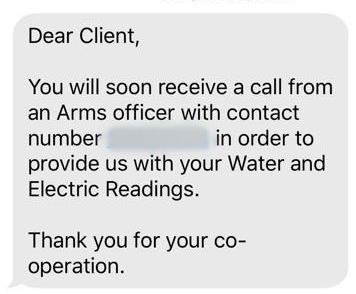Many people have received an SMS from ARMS Ltd, reading that they will receive a call from one of their officers in order for the client to provide water and electricity readings. However, considering the meter readings are meant to be automatic, many questioned why they had to submit their own readings.
When the question was raised as to why meter readers were still being sent, prior to COVID-19, considering the implementation of the ‘smart’ meter system, ARMS had replied that they were required to complement the system and to ensure actual readings are obtained.
Now, during these Coronavirus times, a spokesperson for ARMS has confirmed that the meter readers are working remotely, and that this is being done to attain and input client readings when necessary.
“This happens when readings are not obtained via AMM (automated metering) and ARMS will require manual intervention, or when readings need to be verified. The aim is to always send a correct bill based on actual readings,” the spokesperson explained.
ARMS continued to add that: “the new procedure currently being adopted at this time, is that we send out an SMS to inform clients that a meter reader will be calling them to verify the actual reading. The SMS contains the number from which the call will be made, a mobile number attached to an ARMS employee that one can call back, and this, to put the client’s mind at rest that the call is legitimate.”
This procedure is complementing the smart metering system to ensure that clients receive accurate bills, and the response is positive and has been very encouraging.”

The Malta Independent had revealed, in October 2019, that meter readers were still visiting homes to check readings manually, before COVID-19, even though Enemalta said that 99% of electricity meters are smart meters.
According to the ARMS Ltd website, “The smart electricity meter is an advanced meter that can store information (such as consumption readings) and transmit the data via a network to a central system. It can also receive commands from a remote location. The old meter does not permit any of this. In the case of old meters, consumption has to be read manually, and it is unable to communicate to and from a central system.”
ARMS had also told this newsroom that “one also has to keep in mind that readings for billing are required in a very specific time window and if there is an intermittent fault, it may be necessary to send a meter reader to try to obtain an actual reading for billing purposes.”
Another reason why a meter reader is sent is when a module has not yet been installed, as is the case for some water meters, ARMS had added.
While Enemalta has said that 99% of electricity meters are smart, it noted that 85% of these smart meters are “reached”, when asked for the percentage of meters that send their readings automatically.
In 2009, Enemalta began installing smart meters and water probes as part of a pilot project. It was then reported that the planned replacement of all electricity and water meters would cost €47 million and would enable remote, real-time and accurate meter reading. This would make physical meter reading and billing based on consumption estimates unnecessary.
During this time, it was also reported that people already employed with the Water Service Corporation, especially those employed as meter readers, would be retrained to run the system and perform inspection duties.